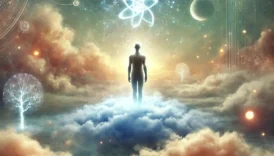The Connection Between Dreams and the Subconscious Mind
Dreams have captivated human curiosity for centuries, offering a glimpse into the mysterious workings of the subconscious. Each night, as we drift into sleep, we transition from the conscious world into the depths of the subconscious, where dreams unfold. These nightly experiences often reflect suppressed emotions, unresolved conflicts, and hidden desires. But how exactly do dreams relate to the subconscious, and what insights can they provide?
- The Connection Between Dreams and the Subconscious Mind
- What Is the Subconscious Mind?
- Layers of the Mind
- The Role of Dreams in Connecting to the Subconscious
- 1. The Purpose of Dreams
- 2. Symbols in Dreams
- Carl Jung and the Collective Subconscious
- Jung’s Archetypes in Dreams
- Scientific Perspectives on Dreams and the Subconscious
- 1. REM Sleep and Dreaming
- 2. Psychological Studies
- Using Dreams to Explore the Subconscious
- 1. Keeping a Dream Journal
- 2. Free Association
- 3. Therapeutic Dream Analysis
- Common Dream Symbols and Their Subconscious Meanings
- Dreams as a Gateway to the Subconscious
- References
In this article, we delve into the intricate relationship between dreams and the subconscious mind, drawing on psychological theories and scientific findings to explore this profound connection.
What Is the Subconscious Mind?
The subconscious is the part of the mind that operates beneath conscious awareness, influencing thoughts, feelings, and behaviors. Sigmund Freud, one of the pioneers of modern psychology, described the subconscious as a reservoir of repressed memories, desires, and instincts.
Layers of the Mind
Freud’s model divides the mind into three main layers:
- Conscious Mind: The thoughts and perceptions we are actively aware of.
- Subconscious (Unconscious) Mind: The hidden layer containing emotions and memories that shape our behavior.
- Preconscious Mind: The bridge between the conscious and subconscious, holding thoughts that can be retrieved when needed.
Source: Freud, S. (1900). The Interpretation of Dreams.
The Role of Dreams in Connecting to the Subconscious
Dreams serve as a gateway to the subconscious mind, providing a unique window into suppressed emotions and unresolved conflicts. Freud famously referred to dreams as “the royal road to the unconscious,” emphasizing their significance in understanding the mind.
1. The Purpose of Dreams
Dreams allow the subconscious to communicate with the conscious mind, often revealing hidden truths or unresolved issues. Examples include:
- Running but getting nowhere: Reflects feelings of frustration or stagnation in waking life.
- Falling from a height: Symbolizes fear of failure or loss of control.
2. Symbols in Dreams
Dreams often use symbolic language to convey subconscious messages. Freud believed these symbols are metaphoric expressions of suppressed desires:
- Water: Represents emotions or subconscious processes.
- A house: Symbolizes the self or the dreamer’s mental state.
- Mirrors: Indicate self-reflection or identity exploration.
Carl Jung and the Collective Subconscious
Carl Jung, a student of Freud, expanded on the idea of the subconscious by introducing the concept of the collective unconscious. According to Jung, dreams are not only personal but also tap into universal experiences and archetypes shared by humanity.
Jung’s Archetypes in Dreams
Jung identified recurring symbols, or archetypes, in dreams that reflect shared human experiences:
- The Hero: Embodies personal growth and overcoming challenges.
- The Shadow: Represents repressed fears or darker aspects of the psyche.
- The Anima/Animus: Reflects the dreamer’s inner feminine or masculine qualities.
Source: Jung, C. G. (1968). Man and His Symbols.
Scientific Perspectives on Dreams and the Subconscious
Modern science has provided valuable insights into how dreams reflect subconscious processes. Advances in neuroscience and psychology have helped demystify the brain’s activity during sleep.
1. REM Sleep and Dreaming
Most vivid dreams occur during REM (Rapid Eye Movement) sleep. During this phase, emotional centers of the brain, such as the amygdala and hippocampus, are highly active. This explains why dreams often have a strong emotional component.
2. Psychological Studies
Psychological research supports the idea that dreams are an extension of waking life. George Domhoff’s studies suggest that dreams reflect the dreamer’s concerns, emotions, and unresolved conflicts.
Source: Domhoff, G. W. (2003). The Scientific Study of Dreams.
Using Dreams to Explore the Subconscious
Dreams can be a powerful tool for self-discovery and understanding the subconscious. Here are some methods to interpret and analyze dreams effectively:
1. Keeping a Dream Journal
Recording dreams immediately upon waking helps identify recurring themes and symbols, offering insights into the subconscious.
2. Free Association
A technique introduced by Freud, free association involves connecting symbols from dreams to thoughts and emotions, revealing hidden meanings.
3. Therapeutic Dream Analysis
In psychotherapy, dream analysis is used to explore subconscious conflicts and assist individuals in achieving emotional clarity.
Common Dream Symbols and Their Subconscious Meanings
Dream symbols often represent hidden thoughts or emotions. Here are some examples:
- Closed Doors: Represent obstacles or repressed feelings.
- Open Skies: Symbolize freedom or spiritual awakening.
- Being Chased: Reflects avoidance of unresolved issues.
Dreams as a Gateway to the Subconscious
Dreams serve as a bridge between the conscious and subconscious mind, offering a glimpse into hidden thoughts, fears, and desires. Freud’s theories highlight dreams as expressions of repressed emotions, while Jung emphasizes their universal and collective nature.
Understanding the relationship between dreams and the subconscious allows us to explore our inner world, fostering self-awareness and personal growth. By analyzing dreams, we can unlock the mysteries of the subconscious, gaining valuable insights into our emotions, behaviors, and motivations.
References
- Freud, S. (1900). The Interpretation of Dreams.
- Jung, C. G. (1968). Man and His Symbols.
- Domhoff, G. W. (2003). The Scientific Study of Dreams.
- Hobson, J. A. (2002). Dreaming: An Introduction to the Science of Sleep.
This comprehensive exploration of dreams and the subconscious provides a foundation for understanding the deep connection between the mind’s conscious and hidden realms.





